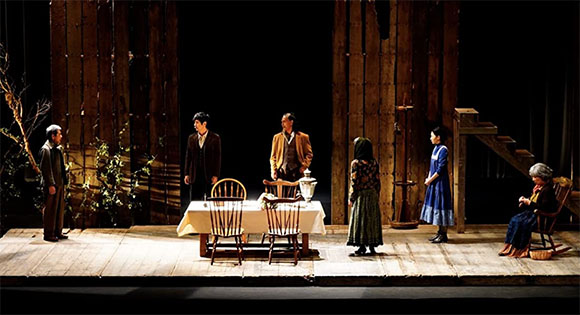How director Ryusuke Hamaguchi utilises unorthodox theatrical flair in film:
Theatre.
An art form that not only enthrals, but completely captures and mesmerises the audience. The dialogues, monologues and portrayal of characters allow us to immerse ourselves in a journey filled with empathy, excitement and emotion.
However, have you ever thought about forming a connection between two forms of media simultaneously? Japanese director Ryusuke Hamagachi sure did, with his masterful and award-winning adaptation of “Drive My Car”, a stunningly powerful narrative about grief, love and emptiness written by Haruki Murakami, propelled through the wonderful art of theatre.
The movie revolves around the life of protagonist Yusuke, played by Hidetoshi Nishijma, as he leads the reproduction of the play “Uncle Vanya”, a real Russian play originally scripted by playwright Anton Chekhov in the late 1800s. Murakami (and thus, Hamaguchi) utilises this play and makes substantial modifications to it in order to better irradiate the movie’s cast.
“Drive My Car” thoroughly depicts theatrical development and production through the elucidation of a group of multilinguistic strangers forming the theatre’s cast, composed of actors speaking English, Chinese, Japanese, Tagalog and even Korean Sign Language. During pre-show rehearsals, the actors do not understand each other, which begs the question: How can the show succeed if neither actors nor audience understand the play? The answer lies between the spoken dialogue: Despite not understanding the multitude of languages being spoken, the genuineness of emotional impact still inevitably lands, even if not explicitly conveyed.
Cleverly enough, the multilingual dialogue has nothing to do with the play. Hamaguchi sheds emphasis on both stage movement and the reliance on ambient sounds, which achieves a degree of universal understanding from audience members. An example of this comes fairly early in the play, when Vanya and his wife lose their newborn daughter. To exemplify the themes of grief and loss by simulating a mourning sequence, Hamaguchi utilises the sound of heavy rain banging upon the roof, allowing both the audiences in and outside the movie to feel the family’s emotional pain.
Hamaguchi essentially manifests his excellence in theatrical storytelling by creating a non-dialogue reliant medium of communication for the theatre’s audience, utilising the aforementioned stage elements to convey the main thematic ideas in “Uncle Vanya” and express the play’s impeccable moments of tension and emotion.
Interconnectedness between “Uncle Vanya” and “Drive My Car”
Hamaguchi’s genius goes beyond deploying superb theatrical techniques.
“Uncle Vanya” is not only a show found in the film itself, but also encompasses and illuminates the entirety of the film’s plot through clever symbolism and foreshadowing clues. This is where Hamaguchi truly displays his elegant take on how theatre connects with life.
The movie begins with the audience witnessing Yusuke grieving his wife, Oto. He then meets a middle-aged girl, Misaki, who the theatre’s association appoints as his new chauffeur, worried that he would spiral out of control due to his loss and conduct self-harm. Misaki acts sorrowful and emotionless throughout the majority of the film, oblivious and sometimes confused about the nuances of the real world. The two share an obvious similarity as they slowly construct an everlasting bond over the course of the movie. It is then revealed that Misaki, like Yusuke, lost her mother when she was a child.
Hamaguchi aims for a strong, but not exact, connection between “Uncle Vanya” and the plot of the movie, paralleling certain elements of emotionality. A review of a production of “Uncle Vanya” in 1946 states, “In Chekhov’s world, humans dream, hope and struggle against hopelessness and bitterness,” which parallels the mourning by the two main characters.
The best example of the connection between the two pieces of media comes at the climax, where Misaki and Yusuke drive to Misaki’s old hometown, where she lost her mother. The two slowly travel through a barren snowscape while occasional conversation ensues, as they slowly open up to each other about their respective losses.
When they reach Misaki’s old home, Hamaguchi perfectly recreates the theatrical techniques used in “Uncle Vanya” — no dialogue, no release of cathartic tension, only a voiceless, silent ambience as we see the two characters quietly mourn as snowflakes gently fall beside them. As an audience member, you can feel the emotions and achieve a genuine level of empathy that completely transcends linguistic communication. This is the true masterwork in Hamaguchi’s craft.
All in all, “Drive My Car” is an absolutely spectacular 179 minutes on the big screen. Hamaguchi not only sheds light on theatre to the world’s audiences, but also manages to display an intricate interconnectedness between theatre and film that I have never seen before. It is simply a must-watch for anyone with a strong affinity for theatre and/or film.

